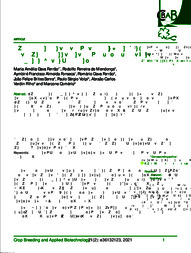Characterization and genetic diversity of Coffea canephora accessions in a germplasm bank in Espírito Santo, Brazil.
Characterization and genetic diversity of Coffea canephora accessions in a germplasm bank in Espírito Santo, Brazil.
Author(s): FERRAO, M. A. G.; MENDONÇA, R. F. de; FONSECA, A. F. A.; FERRÃO, R. G.; SENRA, J. F. B.; VOLPI, P. S.; VERDIN FILHO, A. C.; COMÉRIO, M.
Summary: The state of Espírito Santo is the major producer of Coffea canephora in Brazil. Knowledge of genetic reserves is fundamental to plant breeding. Therefore, the present study characterized and analyzed the genetic diversity of 600 C. canephora accessions from the germplasm bank of Incaper based on 38 traits evaluated in 24-30-month-old plants. Further, the predominant descriptors or traits were identified, and high phenotypic variability was determined. Genetic distances for the grouped (Gower), quantitative, and qualitative datasets were 0.48, 0.61, and 0.92, respectively, with accessions 76 (Conilon) and 407 (Robusta) being the most divergent ones at Incaper. In clustering using the Tocher optimization method, 30 groups were formed, with three accessions introduced from Epamig?s Robusta collection being the most dissimilar ones. Graphical dispersion analysis using the principal coordinate method revealed the predominance of three groups formed by the Robusta, Conilon, and hybrid Robusta × Conilon genotypes.
Publication year: 2021
Types of publication: Journal article
Unit: Embrapa Coffee
Observation
Some of Embrapa's publications are published as ePub files. To read them, use or download one of the following free software options to your computer or mobile device. Android: Google Play Books; IOS: iBooks; Windows and Linux: Calibre.
Access other publications
Access the Agricultural Research Database (BDPA) to consult Embrapa's full library collection and records.
Visit Embrapa Bookstore to purchase books and other publications sold by Embrapa.

